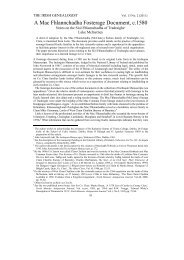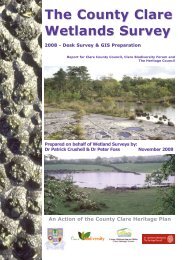Documents from the Thomond Papers at Petworth House Archive1 ...
Documents from the Thomond Papers at Petworth House Archive1 ...
Documents from the Thomond Papers at Petworth House Archive1 ...
Create successful ePaper yourself
Turn your PDF publications into a flip-book with our unique Google optimized e-Paper software.
Archivium Hibernicum<br />
and billeting. 74 The <strong>Thomond</strong> branch of <strong>the</strong> Uí Mhaoilchonaire <strong>at</strong> Ardkyle<br />
were descended <strong>from</strong> <strong>the</strong> two sons of Torna Óg Ó Maolchonaire, Seán and<br />
Muiris, who flourished in <strong>the</strong> sixteenth century 75 making <strong>the</strong>ir presence<br />
in Co. Clare new in comparison to o<strong>the</strong>r families of n<strong>at</strong>ive learning long<br />
settled in <strong>the</strong> county: Mhic Bhruaideadha, Mhic Chraith, Uí Íceadha,<br />
Uí Nialláin, Uí Dhuibhdábhoireann, Mhic Chruitín, Uí Dhálaigh and Mhic<br />
Fhlannchadha.<br />
The Uí Mhaoilchonaire of Ardkyle are credited with penning several<br />
manuscripts in <strong>the</strong> sixteenth century and members of <strong>the</strong> family served<br />
as legal notaries. 76 We find Ilund O Molchonre of Ardkyll as a juror on <strong>the</strong><br />
1586 inquisition into <strong>the</strong> lands of John McNamara held <strong>at</strong> Galway. 77 Ilund,<br />
<strong>the</strong> son of Seán who held Rossmanagher tower-house in Feenagh parish in<br />
1570, 78 is known for his collabor<strong>at</strong>ive work with <strong>the</strong> Uí Dhuibhdábhoireann<br />
family in c. 1569 on <strong>the</strong> law manuscript now known as Egerton 88 and<br />
also in copying <strong>the</strong> Táin Bó Cúailnge saga <strong>at</strong> <strong>the</strong> Uí Mhaoilchonaire school<br />
of history and poetry <strong>at</strong> Ardkyle. 79 Gilla na Naomh Ó hUidhrín’s poem<br />
Tuilleadh feasa ar Éirinn Óigh (‘Fur<strong>the</strong>r knowledge on young Ireland’) and<br />
<strong>the</strong> now lost Leabhar Oiris whose exemplar was copied by <strong>the</strong> poet Dáibhí<br />
Ó Bruadair <strong>from</strong> a copy of <strong>the</strong> original written in 1611, were both produced<br />
<strong>at</strong> <strong>the</strong> Uí Mhaoilchonaire Ardkyle school. 80 Domhnall Ó Maolchonaire<br />
composed <strong>the</strong> poem Créad fá seachnaim síol Aodha? (‘Why do I avoid <strong>the</strong><br />
descendents of Aodh?’) for Seán Mac Conmara, probably on <strong>the</strong> l<strong>at</strong>ter’s<br />
inaugur<strong>at</strong>ion of <strong>the</strong> lordship in c. 1571. 81<br />
74 On <strong>the</strong> lands of west Clann Chuiléin, including Ardkyle, see Luke McInerney, ‘The West<br />
Clann Chuiléin Lordship in 1586: Evidence <strong>from</strong> a Forgotten Inquisition’, pp 33–62, pp 40–<br />
41, p. 43.<br />
75 Paul Walsh, Irish Men of Learning, (Dublin, 1947), pp 34–48.<br />
76 Various members of <strong>the</strong> Uí Mhaoilchonaire <strong>at</strong> Ardkyle are noted as witnesses to deeds in<br />
Irish. See James Hardiman (ed.), ‘Ancient Irish Deeds and Writings Chiefly rel<strong>at</strong>ing to<br />
Landed Property <strong>from</strong> <strong>the</strong> Twelfth to Seventeenth Century: With Transl<strong>at</strong>ion, Notes and a<br />
Preliminary Essay’, pp 1–95. A land deed d<strong>at</strong>ed 1573 and written ‘on <strong>the</strong> green of Bunr<strong>at</strong>ty’<br />
by Tornae (Torna) Ó Maolchonarie is of particular significance as <strong>the</strong> deed refers to <strong>the</strong><br />
Rodan family (‘muintir Rodain’) as stewards of <strong>the</strong> Earl of <strong>Thomond</strong> and to references to<br />
local toponymy (Aylebeg in north-west Bunr<strong>at</strong>ty parish, <strong>the</strong> old orchard, etc), and <strong>the</strong> list of<br />
witnesses including Siacus Ó Conallain, vicar of Bunr<strong>at</strong>ty. Ibid., pp 71–72.<br />
77 R.W. Twigge, ‘M<strong>at</strong>erials’, (BL, Twigge Collection, Add Ms 39260), pp 180–186, p.180.<br />
78 Martin Breen, ‘A 1570 List of Castles in County Clare’, p.132.<br />
79 Brian Ó Dálaigh, ‘The Uí Mhaoilchonaire of <strong>Thomond</strong>’ in Studia Hibernica, xxxv (2009/2010),<br />
pp 45–68, p. 52.<br />
80 Ibid., p. 51 and Kenneth W. Nicholls, ‘The Irish Genealogies: Their Value and Defects’ in The<br />
Irish Genealogist, v, 2 (1975), pp 256–261, p. 258. R.W Twigge quotes <strong>the</strong> colophon of <strong>the</strong> RIA<br />
Ms 23 L.37 as st<strong>at</strong>ing, ‘This genealogy was copied by Daibhi O’Bruadar in <strong>the</strong> year 1671, <strong>the</strong><br />
8th March, <strong>from</strong> <strong>the</strong> Historical Book of Clann Uí Mhaoilchonaire which <strong>the</strong>y compiled 60<br />
years before th<strong>at</strong> period i.e. in <strong>the</strong> year 1611 and was rewritten in Cork by John Stack [Seaghan<br />
Stac], in <strong>the</strong> year of Salv<strong>at</strong>ion 1708’. See R.W Twigge, ‘M<strong>at</strong>erials’, (BL, Twigge Collection, Add<br />
Ms 39264), p. 16.<br />
81 See RIA Ms 784 (q.v. Ms 23.G.9). For o<strong>the</strong>r manuscript versions see Russell Library<br />
Maynooth Ms M107. For a transl<strong>at</strong>ion of <strong>the</strong> poem and historical context see Luke McInerney,<br />
20

















